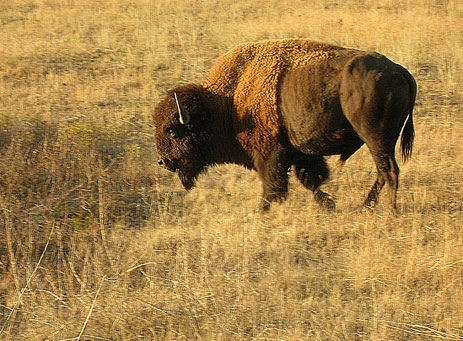Conservation in Action at the American Prairie Reserve

M.S. Earth Systems, 2014
Summer Intern at the American Prairie Reserve
Read about our summer research projects on the OutWest student blog. Throughout the summer, the Center's interns and Research Assistants will be sending in virtual postcards, snapshots and reports on their summer work.
 Last week I made my final trip up to the prairie reserve. On the evening before I left, I went for a run to saturate my senses with the landscape. I eventually came to a valley where I decided to perch on a cottonwood tree and watch the sun go down. I closed my eyes for a few moments, and when I opened them, I saw a buffalo bull a few hundred yards in the distance that must have wandered off on his own. I then turned full circle and realized that I was surrounded by four other bulls that were quickly approaching me. I was overcome with excitement: All of the journals I had read by Lewis and Clark, Edwin Denig, George Catlin and others suddenly came alive, and I imagined an endless grass-filled landscape bursting with millions of buffalo, elk, and antelope and thousands of cougars, wolves, and bears.
Last week I made my final trip up to the prairie reserve. On the evening before I left, I went for a run to saturate my senses with the landscape. I eventually came to a valley where I decided to perch on a cottonwood tree and watch the sun go down. I closed my eyes for a few moments, and when I opened them, I saw a buffalo bull a few hundred yards in the distance that must have wandered off on his own. I then turned full circle and realized that I was surrounded by four other bulls that were quickly approaching me. I was overcome with excitement: All of the journals I had read by Lewis and Clark, Edwin Denig, George Catlin and others suddenly came alive, and I imagined an endless grass-filled landscape bursting with millions of buffalo, elk, and antelope and thousands of cougars, wolves, and bears.
In his book Last Stand, Michael Punke writes, “For emigrants traveling west, sighting the first buffalo marked a signature moment in their voyage – true arrival on the frontier”. Seeing those five buffalo that night represented a frontier for me as well. This frontier is partly physical; I come from mountains and evergreens. Before this summer I had never been to Montana nor had I seen a prairie landscape. In fact, the prairie did not immediately make a big impression on me. At first it seemed like a large expanse of barren nothingness. But then I spent time tearing down a century-old ranch corral, and created just a little more open space so that those bison can roam freely. I also spent a night driving around with a spotlight searching for black-footed ferrets, North America’s most endangered mammal. At 3:30 AM I finally saw a pair of those narrow-set, green eyes peer up at me, and I knew I was seeing one of only 750 in the wild. I came to understand that nature is often invisible to us, but those parts are no less extraordinary than the parts that are conspicuous. I now feel a closer connection to this land than any other I have ever experienced.
The frontier marked by those buffalo is also conceptual. American Prairie Reserve is conducting the largest conservation project in the country, but the project is very much in its early stages. A lot more money needs to be raised for land purchase and restoration before wildlife can thrive again. APR’s bison herd is an essential part of that restoration, because their grazing patterns create a mosaic of habitats for different plant and animal species. Those bison I saw represent beacons of success. They are the embodiment of conservation in action.
At Stanford I take classes in ecology theory and population dynamics, but this internship was truly an invaluable experience in real-life conservation. I got to experience the science, the politics, the labor, and the organizational work, which are all involved in a project of this size. The tasks and obstacles are often daunting, but this internship has renewed my passion for wildlife conservation and I’m excited to return to Stanford with this broader outlook on my field of study.
Right now I am in the final stages of writing my report on historic wildlife populations for APR. This report will need to go through more stages of editing and formatting, but will eventually be turned into a book for donors and visitors. This project is innovative and visionary. To my knowledge, nobody else has attempted to pull together such a variety of information -- scientific, archaeological, literary, and anecdotal -- on historic wildlife populations in northeastern Montana and used that to predict their former abundance. This final publication will be an important tool for APR that will paint a picture for donors of what the historic landscape looked like and provide validity for their restoration. I also had the opportunity to do a blog series about my project for national geographic. This summer has offered me so many extraordinary opportunities and experiences, and I would like to thank American Prairie Reserve and the Bill Lane Center for making it all possible.
Read more at the Out West Blog for Summer Interns »


